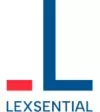1 Legal framework
1.1 Which laws and regulations govern patent litigation in your jurisdiction?
- The IP Code (Decree Law 30 of 10 February 2005); and
- The Civil Procedure Code (as amended by Legislative Decree 149/2022).
1.2 Which bilateral and multilateral agreements with relevance to patent litigation have effect in your jurisdiction?
- The EU Enforcement Directive (2004/48/EC);
- The EU Regulation on the Unitary Patent Court (UPC) (1257/2012); and
- The EU Regulation on Jurisdiction (1215/2012) (as amended, in relation to the UPC system, by EU Regulation 542/2014).
1.3 Which courts and/or agencies are responsible for interpreting and enforcing the patent laws? What is the framework for doing so?
There are 22 Italian courts that specialise in corporate matters. However, if one of the parties is foreign, only 11 courts have the authority to interpret and enforce the patent. The court is composed of a panel of three judges. The patent holder can file an application for limitation of claims in one two ways:
- in ordinary litigation in which the patent is enforced; or
- before the Italian patent office.
In each case, the patent holder gives the patent a different scope of protection (each time narrowing it down compared to the original).
2 Forum
2.1 In what forum(s) is patent litigation heard in your jurisdiction? Are patent infringement and validity decided in the same forum or separate forums?
The specialised courts in corporate matters (see question 1.3). The map below indicates where these specialised courts are located.
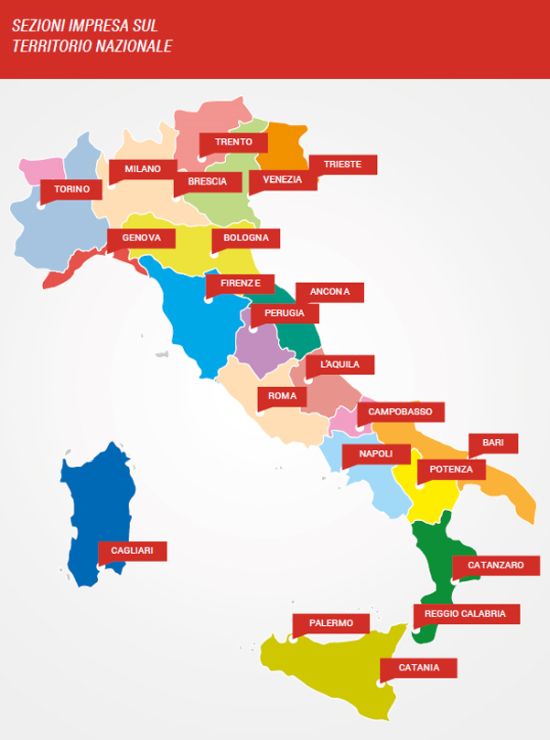
Patent infringement and validity are decided in the same forum. It is possible that two different specialised courts may be seized for the same patent: for example, while a patent infringement case is pending before the Court of Rome (since the infringing company is based in Rome or the infringement took place in Rome), the alleged infringer may start nullity proceedings before the Court of Milan (since the patent holder's elected domicile when filing the patent was in Milan). Following such second case the first one should stay (Supreme Court Decision 8690/2022).
2.2 Who hears and decides patent disputes (eg, a judge, a panel and/or a jury)?
Preliminary injunction litigation is heard by a single judge at first instance and a panel of judges on appeal.
In ordinary litigation, the trial is heard by single judge but the decision is rendered by a panel of three judges.
An appeal is handled by a panel of three judges, one of whom has the role of judge-rapporteur. In the very rare instance where there is a need for a trial phase before the parties are heard by the panel, the president of the panel will appoint a single judge for this phase according to Articles 349bis and 350 of the Civil Procedure Code.
2.3 Are there any opportunities for forum shopping in your jurisdiction? If so, where and how do those opportunities exist?
There are opportunities for forum shopping in Italy. In particular, the following places may serve as an alternative to the place of domicile of the defendant:
- the place where the infringing activity occurred ('infringing activity' is the production, sale, offer to sale, promotion or advertising (even online) of the alleged infringing product/service);
- if there is more than one defendant with a close link to each other, the place where one of the defendants has its head office; or
- where the defendant has no residence, domicile or seat in the national territory, the court of the place where the claimant has residence.
3 Parties
3.1 Who has standing to file suit for patent infringement? What requirements and restrictions apply in this regard?
The patent holder (case law confirms that each patent co-owner can individually sue for infringement), the exclusive licensee and the exclusive distributor have standing. Alternatively, any licensee and distributor may file suit where appropriately authorised to do so by the patent holder.
What requirements and restrictions apply in this regard?
It is preferable to file the licence or distribution agreement or an extract thereof; or to ask the patent holder to take part in the litigation.
3.2 Can a patent infringement suit be brought against a defendant who is a foreign entity with only a residence or place of business outside the jurisdiction?
Yes. Although the Italian judge has no jurisdiction, in some cases he or she may issue a preliminary injunction decision – especially in cases regulated by:
- Article 10 of Law 218/95 (and Article 669ter(3) of the Civil Procedure Code); and
- Article 35 of EU Regulation 1215/2012.
Italian case law also admits cross-border injunctions in regard to patents.
3.3 Can a single infringement action be brought against multiple defendants? What requirements and restrictions apply in this regard?
Yes.
Both the demands and the defendants must be interrelated. 'Interrelated' in this context means that:
- the same patent is infringed; and
- there is a close and concrete relationship between the defendants, according to Article 33 of the Civil Procedure Code.
3.4 Can a third party seek a declaration of non-infringement or invalidity in your jurisdiction? If so, how?
Yes. In starting an action for a declaration of non-infringement, a third party must prove its interest in acting – that is, that the patent holder has threatened its conduct (even through a warning letter or through litigation abroad for enforcement of a patent of the same family). In starting a nullity action, a third party can prove its interest in acting merely by virtue of being a (potential) competitor of the patent holder.
A nullity action is commenced by starting full-scale litigation before the court at the place where the patent holder has its elected domicile.
4 Patent infringement
4.1 What constitutes patent infringement in your jurisdiction?
'Infringing activity' includes the production, sale, offer for sale, promotion or advertisement (even online) of the infringing product. It also includes the production of means related to an essential element of the patented invention which is necessary for its implementation in the territory of a state, if:
- the producer is aware of that destination; and
- the final product is produced or offered on sale in a country in which the invention is protected (Article 66(2)bis of the IP Code).
In the case of a process patent, 'infringing activity' includes:
- the performance of the patented process; and
- the production, sale, offer for sale, promotion or advertisement (even online) of a product obtained directly through the patented process.
4.2 How is infringement determined?
Infringement is determined by proving that the infringer carried out an infringing activity (see question 4.1).
4.3 Does your jurisdiction apply the doctrine of equivalents?
Yes. There are two approaches – the function-way-result (FWR) test and the insubstantive variation theory – both of which were quoted by the Supreme Court in its Decision 2977 of 7 February 2020. In particular:
- in order to ascertain the infringement, the FWR requires a finding that the modified means have substantially the same function in the context of the patent, and obtain the same result in the same way; and
- the insubstantive variation theory (applied recently by the Supreme Court in Decision 30943/2022) recognises infringement if the different solution used by the alleged infringer is obvious (ie, does not present an inventive step) to the person skilled in the art.
4.4 Is wilful infringement recognised? If so, what is the applicable standard?
The specialised courts sometimes consider wilful infringement in quantifying damages. However, punitive damages are not applied, as stated by the Court of Turin in decisions of 8 June 2016 and 3 January 2017.
5 Bringing a claim
5.1 What measures can a patent holder take to enforce its rights in your jurisdiction? Are interim measures available before receiving a ruling on the merits?
The patent holder can request:
- seizure of the infringing goods (Article 129 of the IP Code);
- a preliminary injunction in relation to any infringing activity (Article 131 of the IP Code);
- the withdrawal from the market of the infringing products;
- destruction of the infringing goods and of moulds to produce the infringing goods (Article 124 of the IP Code); and/or
- publication of the decision in newspapers and magazines.
Are interim measures available before receiving a ruling on the merits?
Yes, quite frequently.
A patent holder that lacks proof of infringement and that needs access to the infringer's premises to acquire evidence can request a description (also ex parte) of:
- the infringing products and of the relevant means of production; and
- any technical, commercial and accounting documents (Article 129 of the IP Code).
5.2 What is the limitation period for patent infringement in your jurisdiction?
The only limitation period is for damages and is five years from the date on which the patent holder was aware or should have been aware of the infringement.
5.3 Must the alleged infringer be notified in advance before a claim is brought?
No.
5.4 What are the procedural and substantive requirements for bringing a claim for patent infringement? How much detail must be presented in the complaint?
- The patent annuities must be paid regularly;
- The patent holder and/or the licensee/distributor should bring the claim;
- The patent should be filed; and
- The infringement should be reasonably proved by evidence offered in and filed with the introducing brief (either writ of summons in ordinary proceedings or an application for a preliminary injunction in urgency proceeding).
How much detail must be presented in the complaint?
The burden of proof of the infringement rests with the patent holder. Following the recent modification of the Civil Procedure Code (Legislative Decree 149/2022) on 1 March 2023, when commencing ordinary litigation, the patent holder should provide sufficient evidence. The same can be said of preliminary injunction proceedings. However, if there is a lack of real evidence and only reasonable evidence is available, it may be possible to proceed by requesting an urgent description ex parte (see question 5.2).
The patent holder must file an application for description to obtain access (also ex parte) to a certain site – usually the premises of the alleged infringer or some other site, such as a booth at a trade fair – to describe (and record):
- the contested object;
- all means used to produce the infringing product, including moulds and technical drawings;
- promotional materials;
- accounting documents, including invoices for sales of the contested products or purchases of raw material used to produce the contested product;
- a list of suppliers and clients; and
- a sample of the contested product.
5.5 Are interim remedies available in patent litigation in your jurisdiction? If so, how are they obtained and what form do they take?
Patent litigation in Italy often begins with a preliminary injunction proceeding, followed by ordinary litigation. Interim remedies are also available during ordinary litigation, but are less frequent.
Interim remedies are obtained by filing an application with enclosed evidence that complies with the burden of proof for the patent holder (ie, that proves the infringement took place or has reasonably taken place).
5.6 Under what circumstances must security for costs and/or damages incurred by the other party be provided?
Security for costs and/or damages is seldom requested or fixed by the court.
6 Disclosure and privilege
6.1 What rules on disclosure apply in your jurisdiction? Do any exceptions apply?
Information given by the patent holder to third parties can destroy novelty as pre-disclosure only if people that obtain the information can reproduce the teaching of the patent on their own. However, pre-disclosure does not invalidate the patent application if:
- it takes place within six months of the filing date of the patent application; and
- it is the direct or indirect consequence of a clear abuse against the applicant of such patent application (Article 47.1 of the IP Code).
6.2 What rules on third-party disclosure apply in your jurisdiction? Do any exceptions apply?
Abuse occurs where:
- the invention is disclosed to third parties in breach of a non-disclosure agreement; or
- there is an implicit undertaking of secrecy – for instance, a violation of secrecy carried out by an employee (according to Article 2105 of the Civil Code, employees are bound to secrecy in relation to information owned by the employer and obtained due to their job).
However, case law also confirms that secrecy can be presumed (when not expressly accepted in a clause) in certain commercial relationships (when manufacturing a prototype).
6.3 What rules on privilege apply in your jurisdiction? Do any exceptions apply?
See question 6.2. In any event, if employees are bound to secrecy in relation to information obtained during their relationship with the company, it is recommended that they sign a non-disclosure agreement.
7 Evidence
7.1 What procedure(s) exist for collecting and presenting evidence in patent infringement litigation?
The burden of proof for invalidity falls on the patent holder; while the burden of proof of infringement falls on the alleged infringer. The documentary evidence and a request for deposition of witnesses must be filed with the second trial brief (to be submitted after the writ of summons for the plaintiff; or the first defence for the defendant), according to Article 17ter of the Code of Civil Procedure.
7.2 What types of evidence are permissible in your jurisdiction? Is expert evidence accepted?
In addition to the evidence mentioned in question 7.1, as the judge is not skilled in technical matters relevant to patents, he or she normally appoints, as super partes, a court expert (generally a European patent attorney) who is specialised in the specific field of the patent litigated. The parties are also entitled to appoint their own experts. The experts of the parties will file two or three sets of technical briefs and, subsequently, the court expert will file the draft of a technical opinion, subject to comments by the parties' experts. After taking into account these comments, the court expert will file the final technical report with the judge.
7.3 What are the applicable standards of proof?
Normally, written documents (not affidavits) are relevant. Witness depositions of witnesses are also relevant, but do not generally carry the same weight as documents. However, the probative value of these types of evidence may change on a case-by-case basis.
7.4 On whom does the burden of proof rest?
See question 7.1.
8 Claim construction
8.1 Is there a procedure for construing claims during a patent infringement action? If so, when and how is it performed?
There are no dedicated hearings for claim construction in Italy. A court may conduct a claim construction-type discussion in a hearing – normally once the court expert has submitted his or her technical report, or sometimes before in the case of a technical query.
8.2 What is the legal standard used to define disputed claim terms?
Judges carefully evaluate the scope of the patent. In this regard, according to Article 52 of the IP Code:
- The scope of protection is determined by the text of the claims. However, the description and the drawings shall be used to interpret the claims.
- The provision set forth in paragraph 2 must be read so as to afford, at the same time, an equitable protection to the holder and a reasonable legal certainty to third parties
8.3 What evidence does the court consider in defining the claim terms?
In addition to the evidence outlined in XXX, the court also considers the general common knowledge of the person skilled in the art. In certain cases, case law gives relevance to disclaimers or other declarations made by the patent holder, either before the courts (including in another jurisdiction) or before a patent office (in particular, arguments made by the patent holder during prosecution before the European Patent Office).
8.4 Can the claims of a patent be amended in the course of the proceedings?
Yes, at any time throughout the entire litigation. However, recently the Court of Appeal of Milan declared that such limitation should be carried out during the trials, or immediately after, as if it is carried out close to the hearing of the final statement, it may be considered invalid as abusive conduct. Case law often holds that the amendment can be requested only in the context of an ordinary proceeding in which the validity of the patent is assessed.
9 Defences and counterclaims
9.1 What defences are typically available in patent litigation?
The most relevant defences are a request for nullity of the patent and non-infringement.
9.2 Can the defendant counterclaim for revocation or invalidation of the patent? If so, on what grounds and what is the process for doing so?
Yes. It is compulsory to counterclaim, with the first brief to be submitted 70 days before the first hearing.
9.3 Are there any grounds on which an otherwise valid patent may be deemed unenforceable against a defendant?
A valid patent is unenforceable if the defendant proves, in relation to the contested products, that there has been an exhaustion of rights due to prior sale – in particular, in case of parallel imports from EU countries.
10 Settlement
10.1 Are mediation and/or other forms of settlement discussions required by the court in your jurisdiction or merely optional to the parties?
Mediation and/or other forms of settlement discussions are not required in patent litigation in Italy.
10.2 Can the proceedings be stayed or discontinued in view of settlement discussions?
According to Article 296 of the Civil Procedure Code, all parties to the case can request the judge to stay the claim only once, and for no more than three months. It is common practice in Italy, in case of negotiation, to request postponement rather than for the claim to be stayed.
10.3 Is it necessary to report the results of settlement discussions to the court? If so, how; and what are the implications?
It is good practice to communicate the results of the settlement discussions to the judge directly – in particular, to obtain a further postponement of the hearing in order to settle the litigation.
11 Court proceedings for infringement and validity
11.1 Are court proceedings in your jurisdiction public or private? If public, are any options available to the parties to keep the proceedings or related information confidential?
Normally, court proceedings are private in Italy.
11.2 Procedurally, what are the main steps in patent infringement proceedings in your jurisdiction? Is patent validity handled in the same proceedings as infringement or is it handled separately? If separate validity proceedings are available, what are the main steps in those proceedings?
The timelines are outlined below.
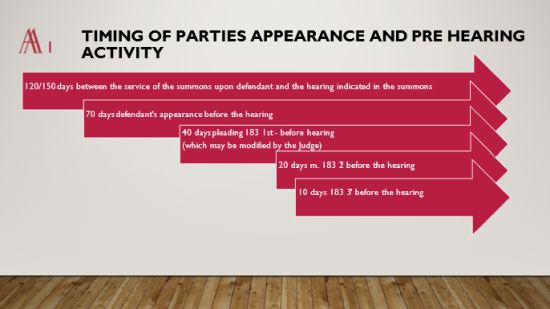
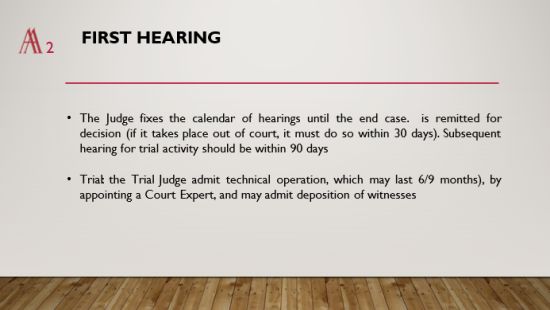
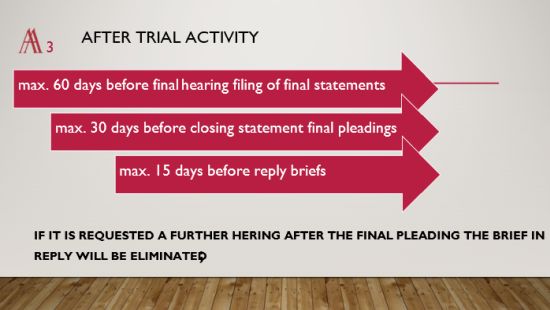
11.3 What is the typical timeframe for patent infringement proceedings? If separate patent validity proceedings are available, with is the typical timeframe for those proceedings?
In an action for nullity and infringement, it takes around two to three years for a decision on infringement to be issued; and if the decision is favourable, it takes an additional two years to decide on damages. However, these timings can be quite unpredictable, as the duration may change from court to court and the application of new procedural rules will also affect it.
11.4 To what extent do the decisions of national or foreign courts or bodies influence the court's decision?
UK and German decisions are taken into account as an element of proof. However, Italian judges refrain from fully relying on these decisions – not least as it may be possible that decisions from these jurisdictions in relation to the same patent may conflict.
12 Remedies
12.1 What remedies for infringement are available to a patent holder in your jurisdiction?
A patent holder can request:
- seizure of the infringing goods;
- an injunction on infringing activity;
- withdrawal from the market of the infringing products;
- destruction of the infringing goods and of the moulds to produce them;
- publication of the decision in newspapers and magazines; and
- damages.
12.2 Are punitive or enhanced damages available in your jurisdiction? If so, how are they determined?
There are no punitive damages; but in case of wilful infringement, the court may increase the damages awarded. In certain cases, the court has considered an increase in reasonable royalties or liquidated damages corresponding to the benefit obtained by the infringer, not extending the damages to include not only net profit, but also gross margin (Appeal Court of Bologna, 27 January 1996).
12.3 What factors will the courts consider when deciding on the quantum of damages?
According to Article 125 of the IP Code, there are three possible criteria to quantify damages:
- compensation for damages calculated as loss of profits, as well as possible real or actual damage and, in appropriate cases, immaterial damage;
- compensation for damages calculated on an equitable basis as, at a minimum, the royalty that the infringer would have paid to obtain a licence; and
- restitution of the profits obtained by the infringer.
13 Appeals
13.1 Can the decision of a first instance court or body be appealed? If so, on what grounds and what is the process for doing so? Please also describe the availability and process for additional levels of appeal.
Yes. First-instance decisions can be challenged before the competent court of appeal according to Article 342 of the Code of Civil Procedure. An appeal against a first-instance decision must be filed within 30 days of service of the decision or, where there is no service of the decision, within six months.
If the appeal is clearly ungrounded, the court seized may rapidly fix a hearing and pronounce orally that the appeal should be dismissed.
The timeframe for appeal proceedings is outlined below.
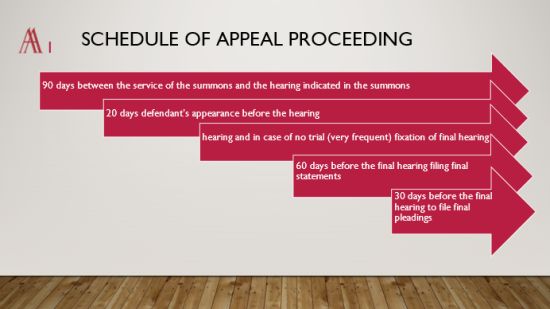
The decision of the court of appeal can be further appealed to the Supreme Court in cases involving:
- national and international jurisdiction;
- violation of law;
- nullity of the appealed decision; or
- lack of examination of an essential fact discussed by the parties. However, this ground for appeal will not apply if both the first and second-instance courts evaluated the same essential fact in the same way.
The appeal must be filed within 60 days of service of the decision or, where there is no service of the decision, within six months.
13.2 What is the average time for each level of appeal in your jurisdiction?
It is extremely difficult to predict the average time for each level of appeal due to the very recent modification of the procedural rules. In particular, these may change from court to court. At the Milan Court of Appeal, an appeal takes around two to three years; whereas this is normally shorter in Turin.
A Supreme Court appeal can take between three and four years, although this is expected to become quicker as a result of the modification of the procedural rules.
14 Costs, fees and funding
14.1 What costs and fees are incurred when litigating in your jurisdiction? Can the winning party recover its costs?
Patent litigation normally involves both infringement and validity issues. The costs may differ significantly on a case-by-case basis. Generally, pharmaceutical cases are more complicated; and the number of patents litigated may also have an impact on costs. This is why normally, in first-instance patent litigation, the legal fees may vary from $64,000 to $128,000 – and sometimes even higher.
Can the winning party recover its costs?
Yes, about 30% to 40% of the costs can be recovered.
14.2 Are contingency fee and/or other alternative fee arrangements permitted in your jurisdiction?
No, but it is possible to calculate the fees based on the economic interest or the result expected by the party (ie, on the basis of the claims of the action or the value of the subject matter). In addition, it is possible to agree, in writing, on a determined fee (added to the ordinary fee) that is due only if the outcome is favorable to the client.
14.3 Is third-party litigation funding permitted in your jurisdiction?
Yes, it is permitted, but there are no specific applicable legislative or regulatory provisions.
As there are no specific norms on litigation funding, the general civil laws of contracts (in particular, mortgage and insurance contracts) will apply. Moreover, the assignment of the position of one party in litigation may not be precluded.
15 Trends and predictions
15.1 How would you describe the current patent litigation landscape and prevailing trends in your jurisdiction? Are any new developments anticipated in the next 12 months, including any proposed legislative reforms?
The new procedural rules illustrated in question 11.2 should speed up proceedings.
16 Tips and traps
16.1 What would be your recommendations to parties facing patent litigation in your jurisdiction and what potential pitfalls would you highlight?
Let us consider two scenarios here:
- A patent holder intends to commence litigation; and
- An alleged infringer expects to be sued.
In both cases, it is better to be prepared in advance. In the former case, the patent holder should:
- be aware that it may be attacked with a nullity action in relation to its patent;
- choose from its portfolio the most appropriate patents to enforce (and consider whether to proceed first with a limitation of the Italian portion); and
- evaluate the pros and cons of enforcing one or more patents in a single litigation.
In the latter case, the alleged infringer should obtain an opinion from a patent attorney which should entirely support the demands (of invalidity and lack of infringement) and with all documents to be submitted in the litigation, including affidavits. In particular, in the case of preliminary injunction proceedings, the defendant may have only 10 to 15 days to appear and prepare its defence and file all necessary documents.
The content of this article is intended to provide a general guide to the subject matter. Specialist advice should be sought about your specific circumstances.
